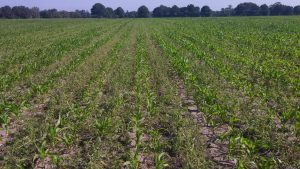Introduction
Many producers have started planting corn or will be doing so in Northeast Florida within the next few weeks. There are several consideration that need to be made to increase seedling germination, stand counts and yield.
Hybrid Selection
There are many considerations for selecting the appropriate corn hybrid to plant. Many growers base their decision on past performance and will choose a hybrid that has a history of high yield. Disease history plays an important role in hybrid selection as well. If you have a history of a particular pathogen in your field, you may need to select a hybrid that has increased resistance to this disease. Another important factor to consider is whether or not the corn is irrigated or on dryland. Drought tolerance is necessary for any corn planted to dryland acres. UF/IFAS Extension conducts yearly corn variety trials to help gather yield data for hybrids grown in Florida. Growers can reference this data to help them select the best performing hybrids.
To view UF/IFAS Field Corn Hybrid Trial Data → CLICK HERE
To view UF/IFAS Silage Hybrid Trial Data → CLICK HERE
Soil Temperature
Producers should consider taking soil temperatures to find the optimal temperature for corn seedling germination, which is > 50°F. When temperatures are below this, germination is delayed and the seed/seedling are subject to herbivory or infection by soil borne insects and pathogens (Figure 1.), respectively.

Planting Depth
The optimum planting depth for corn is 1.75 – 2.25 inches. Corn that is planted too shallow may have trouble establishing brace roots and will have lodging issues later in the season. Corn that is planted too deep may not reach the soil surface after germination. If planting corn early, one should target the more shallow end of the spectrum to ensure that the seedling emerges quickly. Planting equipment should be calibrated each year to ensure the correct planting depth. The tractor pulling the planter should operate at a speed of ~5 mph. If the planter is moved across the field at higher speeds, it is subject to bouncing which can effect the planting depth.
Planting Populations
Data suggests that corn yields are optimized (~250 bushel/acre) at around 32,000 plants per acre.
Pests and Disease
Seed treatment pesticides may need to be applied given the history of pests and disease in a particular field. These include fungicides, insecticides and nematicides. Consult your seed dealer for a list of available seed treatment options.
Weed Populations
Heavy weed populations compete with corn for water, nutrients (and if the weeds are taller than the corn) sunlight (Figure 2). Weed control via mechanical or chemical means, is important to ensure healthy plant stands early in the season.

For more information…
Please click the headings below for more UF/IFAS Extension resources regarding field corn and silage production.
 0
0
